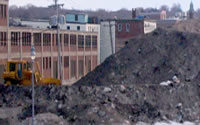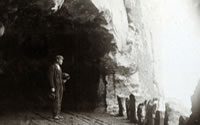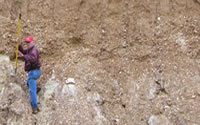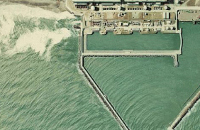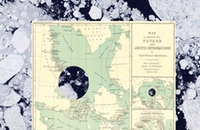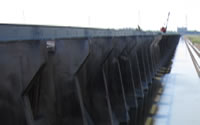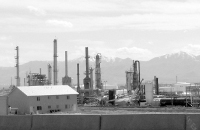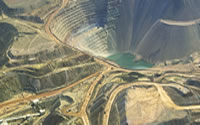Packaging Sludge and Silt
Dredge Research Collaborative (Stephen Becker, Rob Holmes, Tim Maly, and Brett Milligan)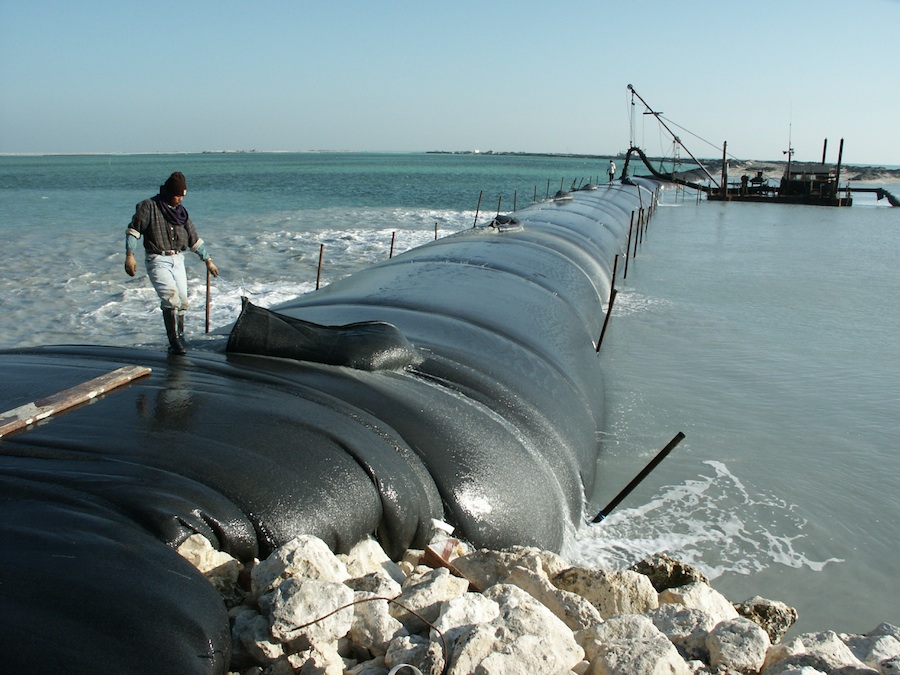
A massive, distended tube thirty feet in circumference and one hundred feet long lies on the bank of a drifting river, among the sludge and muck. A thick hose connected to a dredging barge is filling this black bag with the silt that it is sucking out of a nearby shipping channel. Once full, the tube will be tied shut and left in place. Fluids will slowly seep out, leaving dewatered sediments contained within the casing. This is the geo-tube[1].
A geo-tube is like an oversized[2] sausage casing made of “geotextile,” a synthetic fabric woven primarily from hydrocarbon-derived polymers[3]. When deployed, they are inflated by liquids, slurries, or sediments, depending on their intended use. Geo-tubes find their application where water meets land and where landscape meets industry. They are deployed along riverbanks, coastlines, in shallows, or wetlands. They have spread quickly thanks to their flexibility, speed of application, and cheapness.
Being little more than high-tech fabric bags, geo-tubes have no rigid or complicated parts. They fold away like industrial bedding when not in use; they take on the form of the raw material pumped inside them; they can be deployed in nearly any situation; and they are mass-produced. If the 20th century found much use and appreciation for the small and humble sandbag, the beginning of the 21st century ushered in the increasingly prolific application of its scaled-up successor. The geo-tube embodies shifts from hard strategies of concrete and steel to soft synthetics and engineered biologies, from public state actors to multi-national corporations.
TenCate Geosynthetics is the primary global supplier of geo-tubes. The business is a division of TenCate, an international materials technology conglomerate with divisions specializing in protective fabrics, space and aerospace composites, “advanced armour,” synthetic turf, geosynthetics and industrial fabrics.[4] Their attractive marketing materials divide their geo-tube offerings into two categories. Geotube® Dewatering containers act as a repository for the oft-contaminated silts that are inevitable side effects of water treatment projects, the dredging of navigable channels, and industrial operations ranging from aquaculture to pulp mills. Geotube® Marine Structures act as rapidly-deployed structures, their flexibility and size making them ideal as temporary breakwaters, or for shoreline and island protection, to say nothing of rapid damming, underwater structure creation, sand dune maintenance, wetland creation and protection, jetties, groynes, dikes, and the production of whole new tracts of land. In the domain of coastal construction, there are few situations where geo-tubes are not applicable.
However, these marketing materials are relatively silent on the larger processes and forces that compel us to lay lines of enormous black plastic slugs across fluvial and littoral landscapes which have been eroding and accreting without human assistance for eons. They do not explain that the geo-tube is an ascendant tool in the larger systemics of anthropogenic erosion, what we refer to as the Dredge Cycle.
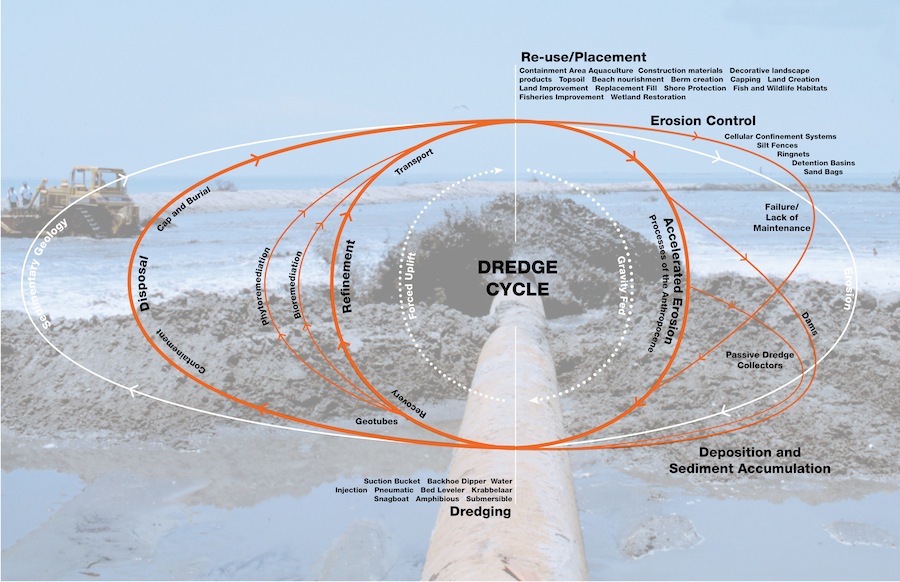
The Dredge Cycle
The Dredge Cycle is not limited to the activities of dredging machines (dredge as a linear act of industrial engineering), but encompasses a much wider range of anthropogenic sediment handling activities and practices. These act upon, feedback to, and destabilize one another, producing a quickened anthropogenic counterpart to conventionally defined geologic cycles.[5] This cycle can be split into two primary phases: anthropogenically accelerated erosion and the manufactured uplift of soil, silt, sand, and sediment. Like the rock, water, and wind cycles, it is ubiquitous, operating wherever humans intentionally or unintentionally move sediment.
The Dredge Cycle is geological in its processes and the material it cycles, but not in its duration. Its unintentional aspects are driven by the assumption of human control over erosive processes (hardtop surfaces prevent the absorption of water, causing accelerated erosion where that water flows; coastal structures alter current patterns, depositing more soil in one area while depriving another). Its intentional aspects are symptoms of economic and political systems that assume stasis in a landscape that was never static (homeowners fight to maintain beaches lest their front yard be washed out to sea; logistics firms demand uninterrupted access to shipping channels). The Dredge Cycle is a crass geology, run on a human timescale.
The Dredge Cycle consequently operates at an ever-increasing pace. The methods used to halt the forces that we set into motion are crude, and routinely throw sedimentary systems out of equilibrium. For instance, when a shipping channel is dredged to deepen it, this destabilizes the riverbed and the channel begins to fill at a faster rate than before the operation, which necessitates further dredging, which produces additional destabilization. Such cycles spiral inward, growing tighter and faster, across the breadth of the Dredge Cycle.
The primary forces driving the Dredge Cycle are urbanization, agriculture, and forest-clearing (which produce erosion on land and siltation in waterbodies), damming (which accelerates siltation in waterbodies), the need to maintain navigation channels for shipping (which requires removing sediment from waterbodies), and the desire to hold in stasis the shape of shorefronts (which typically requires the deposition of sediment to counter erosive forces, both natural and anthropogenic).
There are innumerable infrastructures, devices, machines, and products implicated in the Dredge Cycle: mechanical and hydraulic dredges, pipelines, barges, conveyor belts, trucks, bulldozers, backhoes, earthmovers, geotextiles, silt fences, turbidity curtains, containment booms, cellular confinement systems, sand bags, Hesco baskets, groynes, dams, and more. With this distributed mechanical apparatus, we humans are continually reorganizing the sedimentary geology of six of the seven continents.
Geo-tubes are relative newcomers to these systemics[6], but they represent larger trends within the Dredge Cycle at least as well as any other material technology. The geo-tube is both a response to the increased speed and quantity with which humans encourage sediments to cycle across the surface of the earth, serving to slow coastal erosion, for instance, and a contributor to that process. The geo-tube makes it more convenient -- faster, easier, and cheaper[7] -- than ever to confine, place, and move sediment. This convenience breeds ubiquity; when something is fast, easy and cheap, the tendency is to do more of it. Geo-tubes are consequently one of the many forces driving the expansionary logic of the Dredge Cycle, feeding its tendency to bring ever-increasing quantities of sediment under the influence of human sediment-handling practices[8].
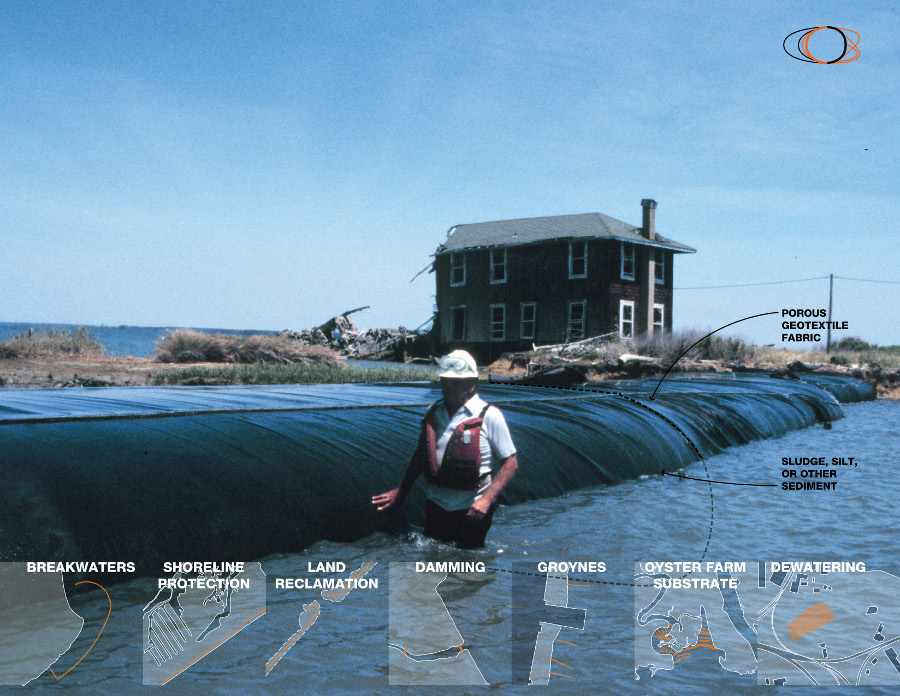
A New Geologic Vernacular
Because of its flexibility and adaptability, the geo-tube is nearly omnipresent in the Dredge Cycle. Like a scaled-up merger between sandbags and silt fences, the geo-tube can be deployed as an erosion control measure that slows accelerated erosion through placement as a physical barrier. When used in erosion control, the geo-tube is itself filled with dredge material harvested from clogged streams, rivers, and bays. Alternatively, when employed as soft dams, where they, like all dams, act to trap sediment and induce siltation. The geo-tubes’ porous synthetic skin allows for the recovery of sediment by permitting the passage of water while trapping suspended particles. This captured material can then be refined, or sorted into clean and contaminated components, which in turn can then be reapplied for a range of ‘beneficial uses,’ including the production of new land, submarine terrain, and landforms. This kind of cyclical feedback, a single technology contributing to the anthropogenic acceleration of erosion while simultaneously trying to decelerate or reverse those effects, is one of the most basic characteristics of the Dredge Cycle.
The geo-tube literally encapsulates the sublime materiality of the Dredge Cycle, as sediment and water in slurried suspension are stuffed into geotextile casings. The Dredge Cycle is fundamentally composed of wet stuff: basic materials; ordinary sand, silt, clay, and water. While it can and should be understood as a highly abstracted set of networks and feedback loops operating on a global spatial scale, it should also be understood as a material operation. It is the cubic yards of excavated soil downwashing across your backyard from the new construction three houses down in a rainstorm as much as it is globally networked processes like the expansion of the Panama Canal to accommodate the importation of goods from East Asia driving port expansions and dredging operations along the East Coast of North America. Similarly, geo-tubes are always dirty: placed in muck, filled with muck, and, like muck, slumping and slouching into soft shapes, rather than following the precise angles of architectural geometry.
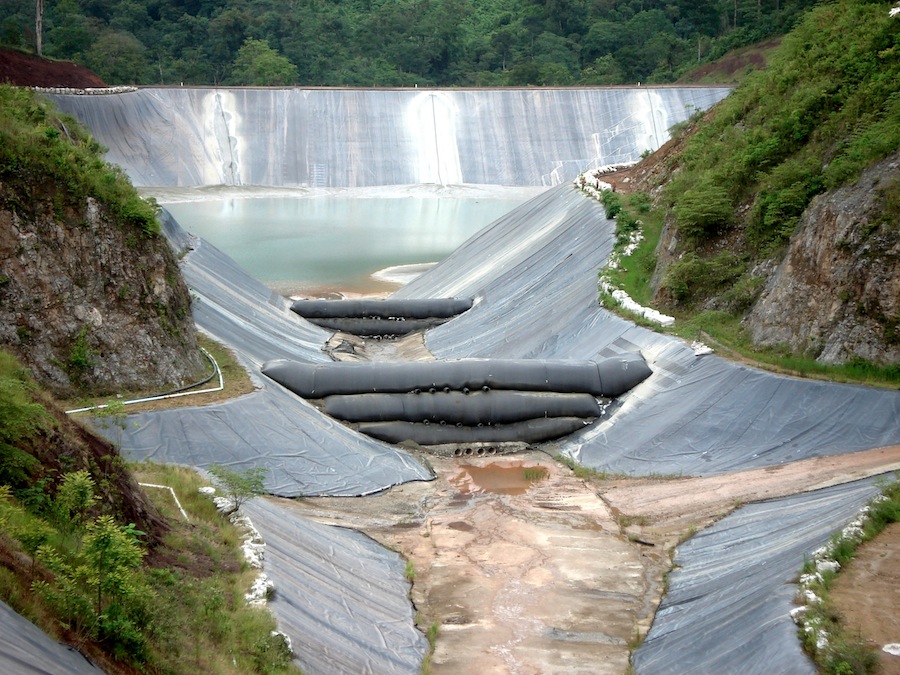
The geometry of the geo-tube is no more natural than the clean modernist lines of the Hoover Dam. It is something else entirely, both post-natural and post-architectural. This seems entirely appropriate for an era in which we are freezing sediment-spraying rivers in specific configurations, like the Mississippi at Old River Control, or impounding the eroded sediments of entire continents behind vast concrete structures, like Three Gorges Dam. Our largest monuments are not pyramids and skyscrapers, but geologic impacts.
The Dredge Cycle is thus landscape design on a deliriously monumental scale, but unrecognized as an architecture. It instead remains the domain of logistics, industry, and engineering. Geo-tubes, like other geosynthetics and indeed nearly all of the infrastructure of the Dredge Cycle, are not usually placed or constructed with a particularly conscious aesthetic aim. Rather, they are part of the infrastructural vernacular of civil engineering's ordinary monuments. When they are used with conscious aesthetic intent, they tend to be hilariously unsuited to the cosmetic tasks they are asked to perform: resort-beach-bound geo-tubes literally whitewashed, for instance, to look sort of like pale sand, which only serves to make them more obviously awkward. However, this abdication of aesthetics is in itself an aesthetic, though a different kind, less conscious, more primal -- which is perhaps its appeal. The greatest aesthetic triumph of the geo-tube is the manufactured Amwaj Island in Bahrain, beneath the sands of which lie the world’s largest geo-tube installation[10]. And the way that the geo-tube is unceremoniously dumped into streams on Filipino golf courses and along Mexican beaches and on the coastal dune-scape of Virginian spaceports captures exactly the unconscious nature of this un-aesthetic, and the weirdness of the geo-tube.
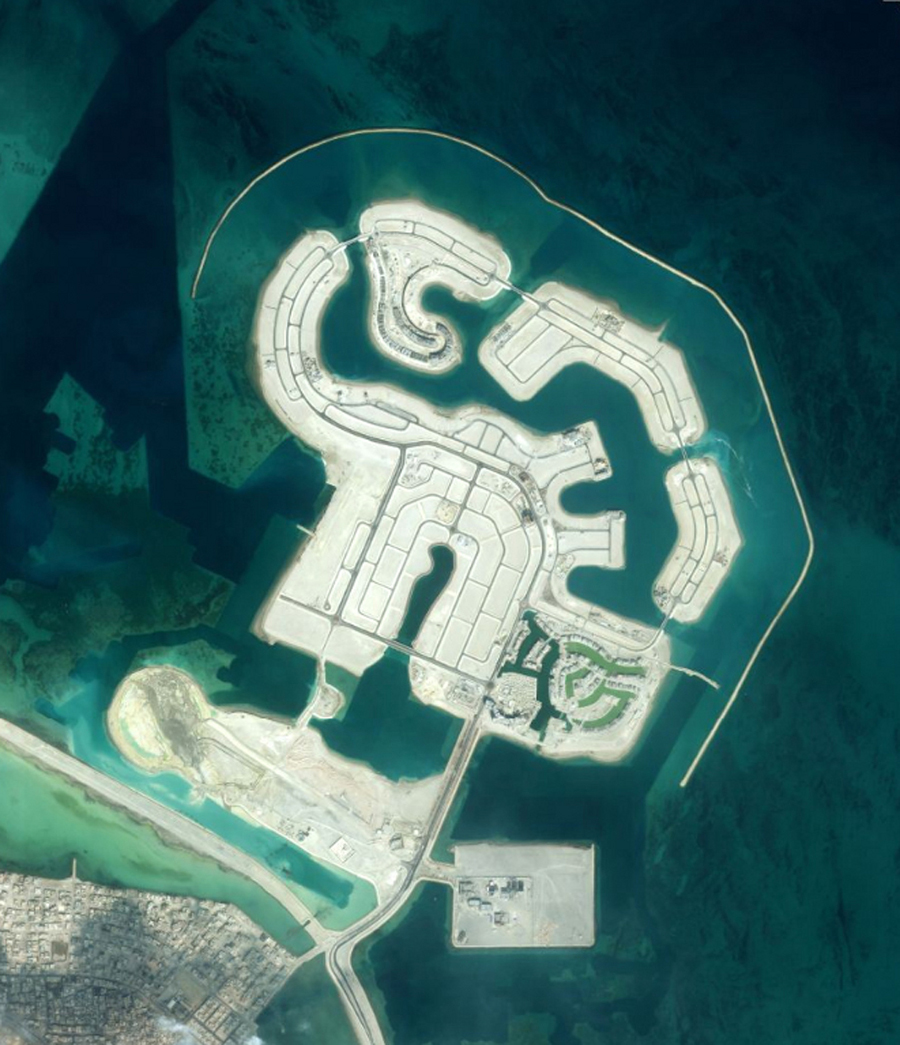
The Anthropocene may have begun accidentally and unnoticed, but now that we have seen it, it is necessarily propelled by choice, by our awareness of our capacity to shape it[12]. As a working material, geo-tubes suggest the possibility of a new soft architecture that at once works with and against geologic forces[13]. In a very physical and material way, these horizontal monoliths open the door for architecture as process, as the conditions under which they are deployed cannot help but suggest structures in the process of accumulating and structures in the process of dissolving.
Geo-tubes embody a new vernacular of engineered geology, of infrastructures for the self-aware Anthropocene. They surprise and captivate us, just as elevated freeway interchanges and massive dams captured the cultural imagination of the last century[14]. They are a harbinger of things to come.
back to top ↑Footnotes
- Here we should distinguish between the generic term “geo-tube,” an abbreviation referring to prefabricated geotextile tubes, a class of applied geosynthetics, and “Geotube® containers,” a particular set of products manufactured and trademarked by TenCate Geosynthetics, a corporation owned by the Dutch materials technology company Royal Ten Cate. TenCate is the primary global supplier of geotextile tubes. ↑
- We use “oversized” advisedly: TenCate currently engineers Geotube® containers in circumferences of up to one hundred feet, with lengths close to five times that.↑
- ASTM D4439, the international materials standard that covers geosynthetics, defines a geosynthetic as “a planar product manufactured from polymeric material, used with soil, rock, earth, and other geotechnical engineering-related material as an integral part of a human-made project, structure, or system.” ↑
- Information on TenCate and TenCate’s products is based upon TenCate’s website, http://www.tencate.com, TenCate’s marketing materials, and conversations with representatives of TenCate. ↑
- By “conventional” or “classical” geology, we refer to models of geologic formation that exclude human influence on geologic processes and forms. Conventional geology can be contrasted with the movement among contemporary geologists to describe the “Anthropocene,” a geologic era characterized by the discernable effect of human activities on the geologic record. The Anthropocene has been described in numerous recent articles in the general press, including a 26 May 2011 editorial briefing in The Economist entitled “The Anthropocene: A Man-made World,” Elizabeth Kolbert’s March 2011 “Age of Man” in National Geographic Magazine, and a 27 February 2011 editorial in The New York Times entitled “The Anthropocene.”↑
- TenCate’s marketing materials indicate that the first installation of geo-tubes was in Europe in 1962. (This installation predates the trademarking of the name “Geotube®”--a trademark was filed with the US Patent and Trademark Office in 1995 -- but the technology appears essentially similar.) Though, like most industrial inventions, the geo-tube has a long international patent history, the most current patent held by TenCate Nicolon is US Patent No. 6,186,701, “Elongate Flexible Container,” filed in 1997 and approved in 2001. The widespread use of geo-tubes in the United States similarly began in the 1990’s and expanded throughout the first decade of the twenty-first century.↑
- Krystian W. Pilarczyk, Geosynthetics and Geosystems in Hydraulic and Coastal Engineering (Brookfield: A.A. Balkema Publishers, 2000), 3. ↑
- It is not at all coincidental, given the role of the corporation in the growth of the Dredge Cycle, that this expansionary logic mirrors the growth logic of the corporation, in which innovation, standardization, and distribution serve to lower production costs, cyclically funding further innovation, increased standardization, and expanded distribution. The Dredge Cycle is what happens when corporate logic is applied to geology.↑
- See “TenCate Geotube® technology in Honduras,” Tencate.com, Spring 2010: http://www. tencate.com/11839/TenCate/Corporate/en/Home/en-Home-Txtures/spring-2010/TenCate-Geotube-technology-in-Honduras.↑
- Per conversations by the authors with representatives of TenCate, 1 September 2011.↑
- Fowler, Jack, et al. “Amwaj Island Constructed with Geotubes, Bahrain,” Geotec Associates: http://www.geotec.biz/publications/Amwaj%20Islands%20Constucted%20with%20Geotubes.pdf ↑
- For a longer exposition of a similar argument, see Andrew Revkin, “Embracing the Anthropocene,” The New York Times [Dot Earth weblog], 20 May 2011: http://dotearth.blogs. nytimes.com/2011/05/20/embracing-the-anthropocene/. ↑
- In a piece, “Dredge,” for the forthcoming publication Bracket 2 (published by Actar and edited by Lola Sheppard and Neeraj Bhatia), we further explore this link between “soft” architecture and the Dredge Cycle. ↑
- See David E. Nye, American Technological Sublime, (Cambridge: MIT Press, 1994). ↑






